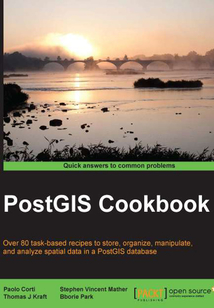舉報 

會員
PostGIS Cookbook
最新章節:
Index
Aneasytouseguide,fullofhandsonrecipesformanipulatingspatialdatainaPostGISdatabase.Eachtopicisexplainedandplacedincontext,andforthemoreinquisitive,therearemoredetailsoftheconceptsused.Ifyouareawebdeveloperorasoftwarearchitect,especiallyinlocationbasedcompanies,andwanttoexpandtherangeoftechniquesyouareusingwithPostGIS,thenthisbookisforyou.YoushouldhavesomepriorexperiencewithPostgreSQLdatabaseandspatialconcepts.
目錄(125章)
倒序
- coverpage
- PostGIS Cookbook
- Credits
- About the Authors
- About the Reviewers
- www.PacktPub.com
- Support files eBooks discount offers and more
- Preface
- What this book covers
- What you need for this book
- Who this book is for
- Conventions
- Reader feedback
- Customer support
- Chapter 1. Moving Data In and Out of PostGIS
- Introduction
- Importing nonspatial tabular data (CSV) using PostGIS functions
- Importing nonspatial tabular data (CSV) using GDAL
- Importing shapefiles with shp2pgsql
- Importing and exporting data with the ogr2ogr GDAL command
- Handling batch importing and exporting of datasets
- Exporting data to the shapefile with the pgsql2shp PostGIS command
- Importing OpenStreetMap data with the osm2pgsql command
- Importing raster data with the raster2pgsql PostGIS command
- Importing multiple rasters at a time
- Exporting rasters with the gdal_translate and gdalwarp GDAL commands
- Chapter 2. Structures that Work
- Introduction
- Using geospatial views
- Using triggers to populate a geometry column
- Structuring spatial data with table inheritance
- Extending inheritance – table partitioning
- Normalizing imports
- Normalizing internal overlays
- Using polygon overlays for proportional census estimates
- Chapter 3. Working with Vector Data – The Basics
- Introduction
- Working with GPS data
- Fixing invalid geometries
- GIS analysis with spatial joins
- Simplifying geometries
- Measuring distances
- Merging polygons using a common attribute
- Computing intersections
- Clipping geometries to deploy data
- Simplifying geometries with PostGIS topology
- Chapter 4. Working with Vector Data – Advanced Recipes
- Introduction
- Improving proximity filtering with KNN
- Improving proximity filtering with KNN – advanced
- Rotating geometries
- Improving ST_Polygonize
- Translating scaling and rotating geometries – advanced
- Generating detailed building footprints from LiDAR
- Using external scripts to embed new functionality in order to calculate a Voronoi diagram
- Using external scripts to embed other libraries in order to calculate a Voronoi diagram – advanced
- Chapter 5. Working with Raster Data
- Introduction
- Getting and loading rasters
- Working with basic raster information and analysis
- Performing simple map-algebra operations
- Combining geometries with rasters for analysis
- Converting between rasters and geometries
- Processing and loading rasters with GDAL VRT
- Warping and resampling rasters
- Performing advanced map-algebra operations
- Executing DEM operations
- Sharing and visualizing rasters through SQL
- Chapter 6. Working with pgRouting
- Introduction
- Startup – Dijkstra routing
- Loading data from OpenStreetMap and finding the shortest path using A*
- Driving distance/service area calculation
- Calculating demographics using driving distance
- Extracting the centerlines of polygons
- Chapter 7. Into the Nth Dimension
- Introduction
- Importing LiDAR data
- Performing 3D queries on a LiDAR point cloud
- Constructing and serving buildings 2.5 D
- Using ST_Extrude to extrude building footprints
- Creating arbitrary 3D objects for PostGIS
- Exporting models as X3D for the Web
- Reconstructing Unmanned Aerial Vehicle (UAV) image footprints with PostGIS 3D
- UAV photogrammetry in PostGIS – point cloud
- UAV photogrammetry in PostGIS – orthorectification
- UAV photogrammetry in PostGIS – DSM creation
- Chapter 8. PostGIS Programming
- Introduction
- Writing PostGIS vector data with Psycopg
- Writing PostGIS vector data with OGR Python bindings
- Writing PostGIS functions with PL/Python
- Geocoding and reverse-geocoding using the GeoNames datasets
- Geocoding using the OSM datasets with trigrams
- Geocoding with geopy and PL/Python
- Importing netCDF datasets with Python and GDAL
- Chapter 9. PostGIS and the Web
- Introduction
- Creating WMS and WFS services with MapServer
- Creating WMS and WFS services with GeoServer
- Creating a WMS Time with MapServer
- Consuming WMS services with OpenLayers
- Consuming WMS services with Leaflet
- Consuming WFS-T services with OpenLayers
- Developing web applications with GeoDjango – part 1
- Developing web applications with GeoDjango – part 2
- Chapter 10. Maintenance Optimization and Performance Tuning
- Introduction
- Organizing the database
- Setting up the correct data privilege mechanism
- Backing up the database
- Using indexes
- Clustering for efficiency
- Optimizing SQL queries
- Migrating a PostGIS database to a different server
- Replicating a PostGIS database with streaming replication
- Chapter 11. Using Desktop Clients
- Introduction
- Adding PostGIS layers – QGIS
- Using the Database Manager plugin – QGIS
- Adding PostGIS layers – OpenJUMP GIS
- Running database queries – OpenJUMP GIS
- Adding PostGIS layers – gvSIG
- Adding PostGIS layers – uDig
- Index 更新時間:2021-07-19 18:30:12
推薦閱讀
- Unity 2020 By Example
- INSTANT Mock Testing with PowerMock
- 微服務設計(第2版)
- Leap Motion Development Essentials
- Android 9 Development Cookbook(Third Edition)
- 數據結構與算法JavaScript描述
- PhpStorm Cookbook
- Learning Zurb Foundation
- Spring快速入門
- Webpack實戰:入門、進階與調優
- Python極簡講義:一本書入門數據分析與機器學習
- Spring 5 Design Patterns
- Mockito Essentials
- Exploring SE for Android
- Android Sensor Programming By Example
- Mastering Python
- 活文檔:與代碼共同演進
- Scratch 3少兒交互式游戲編程一本通
- 物聯網及低功耗藍牙5.x高級開發
- Hands-On Full Stack Development with Angular 5 and Firebase
- Full Stack Development with JHipster
- 走向TensorFlow 2.0:深度學習應用編程快速入門
- 湖南省大學生計算機程序設計競賽試題與應用軟件開發類作品集萃(2005—2016)
- 大學計算機基礎教程
- INSTANT Apache Solr for Indexing Data How-to
- The Data Science Workshop
- Dapr與.NET微服務實戰
- Natural Language Processing with TensorFlow
- Visual Basic編程全能詞典
- Kali Linux:An Ethical Hacker's Cookbook

